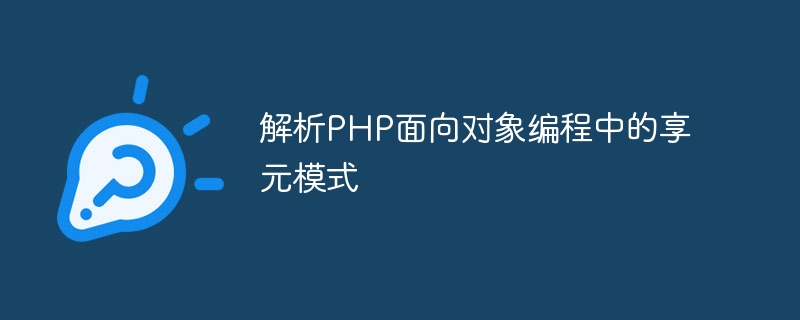

Analysis of Flyweight Pattern in PHP Object-Oriented Programming
In object-oriented programming, design pattern is a commonly used software design method, which can improve the efficiency of the code. Readability, maintainability and scalability. Flyweight pattern is one of the design patterns that reduces memory overhead by sharing objects. This article will explore how to use flyweight mode in PHP to improve program performance.
What is flyweight mode?
Flyweight pattern is a structural design pattern whose purpose is to share the same state or data between different objects to reduce memory usage and improve program performance. When an object instantiated by a class requires a large number of repeated attributes, the flyweight pattern can be used to share these attributes to avoid repeated creation of objects. This way of sharing objects can improve the efficiency of the program.
Code example:
In order to better understand the flyweight mode, let's first look at a simple code example.
class User
{
private $name; public function __construct($name) { $this->name = $name; } public function getName() { return $this->name; }
}
class UserFactory
{
private $users = []; public function getUser($name) { if (!isset($this->users[$name])) { $this->users[$name] = new User($name); } return $this->users[$name]; }
}
// Use UserFactory to get the User object
$userFactory = new UserFactory();
$user1 = $userFactory->getUser("John");
$user2 = $userFactory-> ;getUser("John");
// Output result
echo $user1->getName(); // Output: John
echo $user2->getName(); / / Output: John
echo $user1 === $user2 ? "true" : "false"; // Output: true
In the above code, we created a User class and a UserFactory class. The User class represents a user object, and the UserFactory class is responsible for creating and managing User objects. In the getUser method, first determine whether the user already exists. If not, instantiate a new object; if it already exists, return the existing object directly. In this way, when we use the same user name to obtain the user object, we actually obtain the same object.
Advantages of flyweight mode
Using flyweight mode can provide the following advantages:
Reduce memory overhead: Because flyweight mode shares the same object, it avoids repeated creation of objects overhead, reducing memory usage.
Improve performance: Reduce the time and overhead of creating objects and improve the running efficiency of the program.
Code reuse: By sharing objects, the same object can be used in different places, improving code reusability.
Easy to expand: If there are new requirements, you can add new objects directly to the flyweight factory without modifying the original code.
Notes on using flyweight mode
When using flyweight mode, you need to pay attention to the following points:
Distinguish between internal state and external state: internal state refers to the state that can be shared , will not change with changes in the environment; external state refers to a state that cannot be shared and will change with changes in the environment. When designing the flyweight pattern, it is necessary to separate internal state and external state.
Thread safety: When using flyweight mode in a multi-threaded environment, you need to pay attention to thread safety. Thread safety can be ensured through a locking mechanism.
Conclusion
Flyweight mode is a design pattern that can reduce memory overhead and improve program performance. Using the Flyweight pattern in PHP, you can reduce the cost of repeatedly creating objects by sharing objects. By rationally using the flyweight mode, the efficiency and maintainability of the program can be improved. I hope this article will help readers understand the flyweight mode in PHP.
The above is the detailed content of Analyzing the Flyweight Pattern in PHP Object-Oriented Programming. For more information, please follow other related articles on the PHP Chinese website!